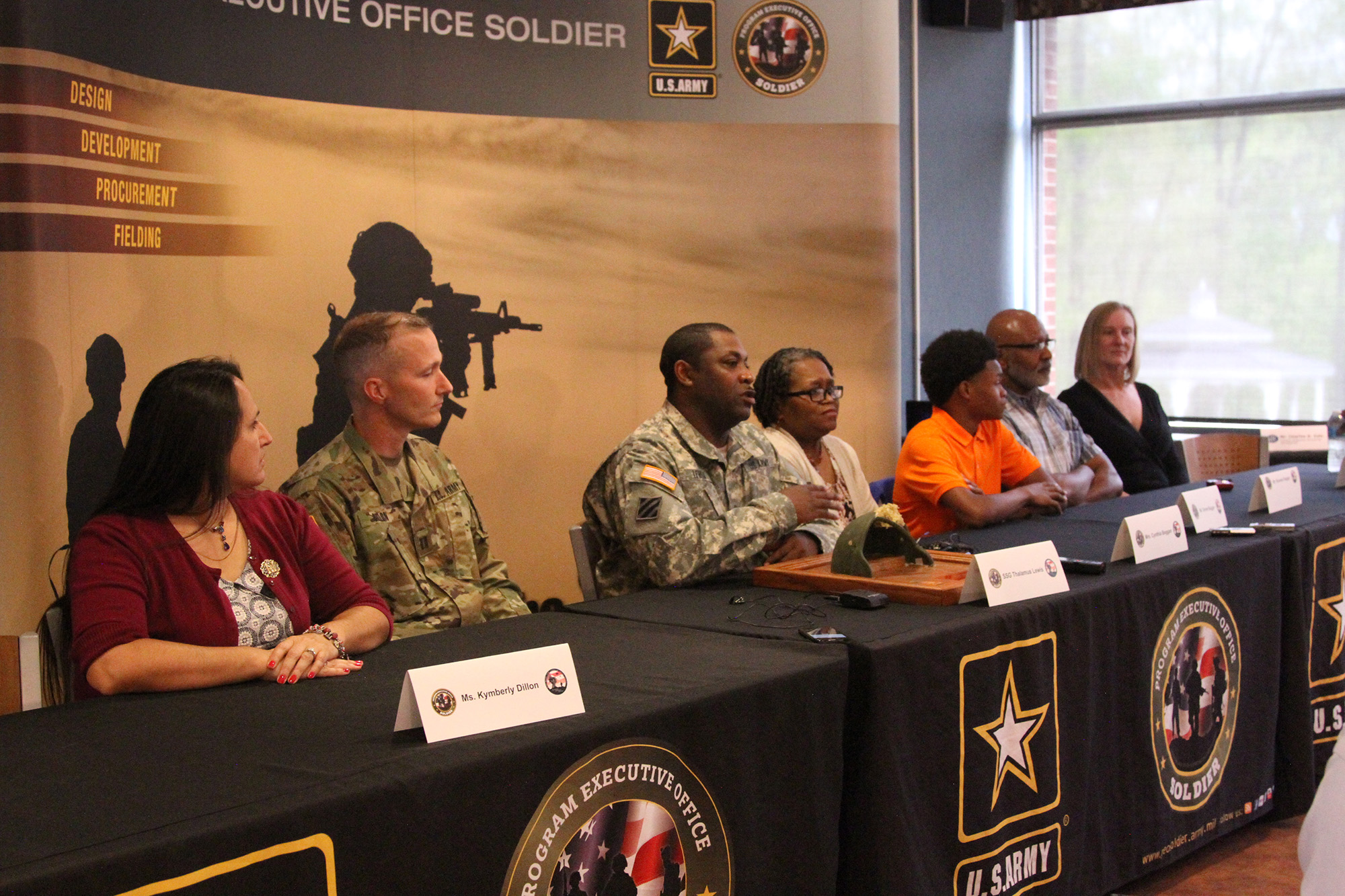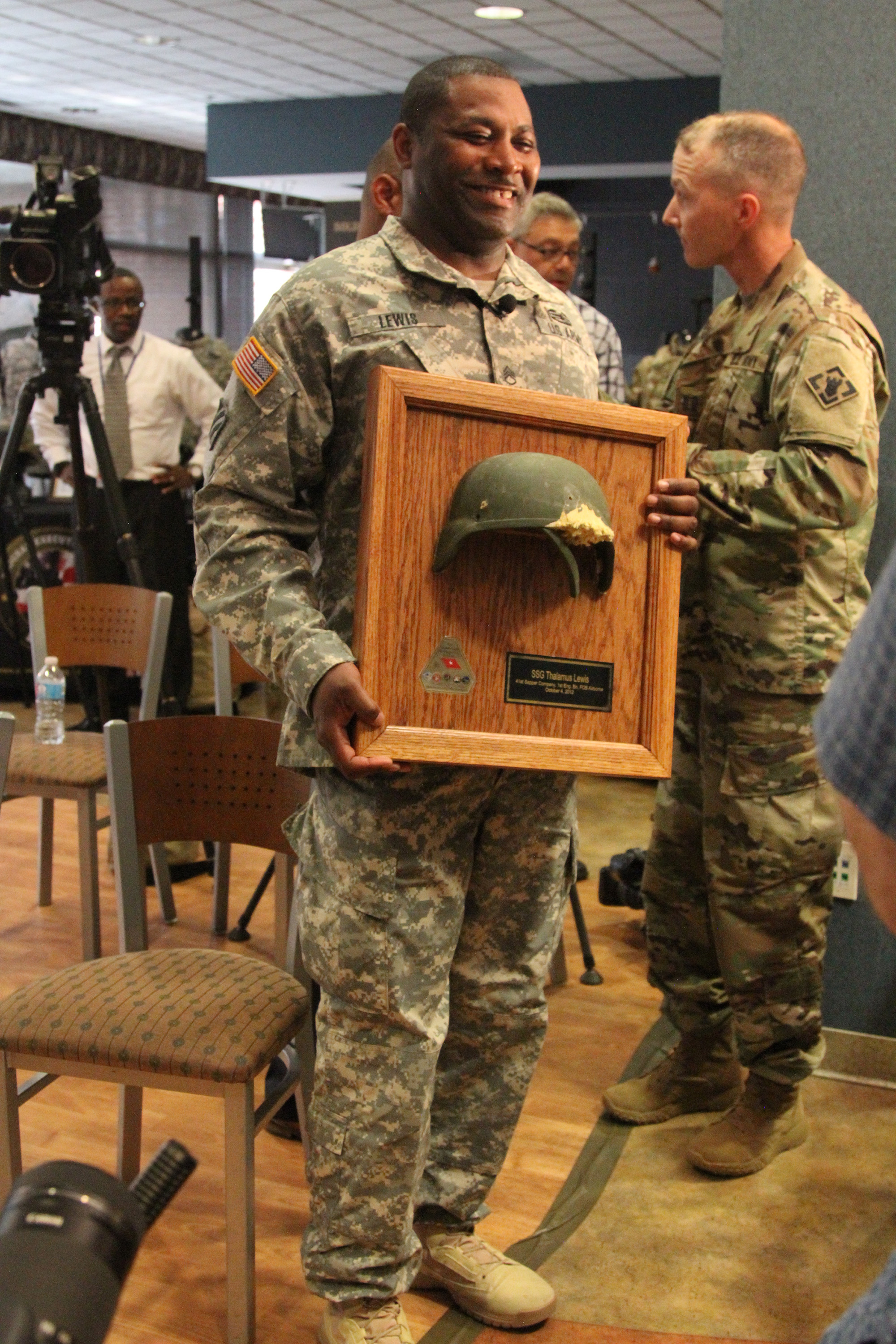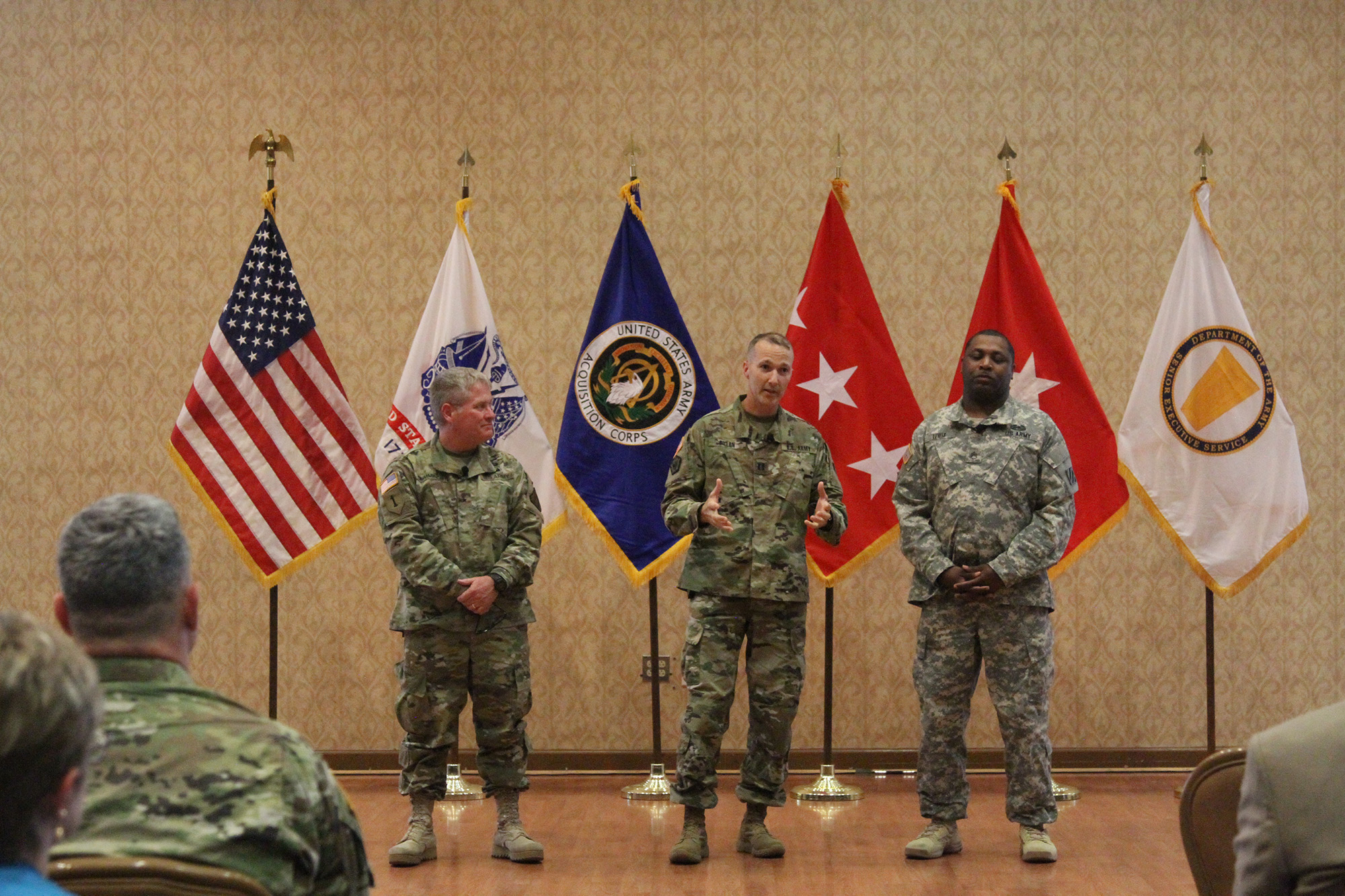
By Michael Bold
FORT BELVOIR, Va.—Army Staff Sgt. Thalamus Lewis found himself lying in the middle of a road in Afghanistan, a firefight raging around him. He didn’t know what had happened, but his instincts told him to “play like a possum and be still.”
Lewis’ instincts probably save his life. “He was smart enough to lay there and not move,” said Capt. Alexander K. Dillon, Lewis’ platoon leader in Afghanistan. Had he moved, he would have surely drawn fire.
What Lewis didn’t know was that his life had been saved twice that day, Oct. 4, 2012. Just seconds earlier he had been saved from a bullet—to the head.
But Lewis is alive and well. His Advanced Combat Helmet (ACH) deflected the bullet. On April 19, Lewis was reunited with the helmet in a ceremony at Fort Belvoir.

Kymberly Dillon; her husband, Capt. Alexander K. Dillon; Staff Sgt. Thalamus Lewis; his mother, Cynthia Boggan; his brother, Tarone Boggan; his father, Ricardo Peagler; and his stepmother, Ruth Peagler, talk to the media Tuesday after the helmet return ceremony. (Photo courtesy of PEO Soldier)
Brig. Gen. Brian P. Cummings, PEO Soldier’s program executive officer, presented Lewis with the plaque-mounted helmet, a large divot missing from the front, where the bullet exited after piercing the ACH above the right ear. “Thank you very much,” Cummings told Lewis at a Fort Belvoir Community Center hall packed with cheering Soldiers and civilians from PEO Soldier, “and you can have your helmet back.”
Lewis was part of a platoon searching for hidden explosives when a bullet slammed into his helmet. Lewis, who was on his fourth deployment, was momentarily knocked unconscious but survived—the helmet absorbed the shock and diverted the bullet.
Dillon said everything happened very quickly. “When we all hit the ground, I saw all the Soldiers behind me that were engaging the enemy, as they were supposed to. I looked back and I saw one of our Soldiers laying in the road. I didn’t know who it was.”

ASA(ALT) Sgt. Maj. Rory L. Malloy, Brig. Gen. Brian P. Cummings, Program Executive Officer Soldier, Staff Sgt. Thalamus Lewis and Capt. Alexander K. Dillon at the Fort Belvoir Community Center on Tuesday. (Photo courtesy of PEO Soldier)
By the time Dillon was able to make his way to the fallen Soldier, who had been taken away to a rear area, “Sgt. Lewis was sitting there, with his Kevlar off, a little bit of blood on his forehead, and he was looking at me. I was very happy to see him looking at me. I can’t tell you how happy I really was.”
“I just kind of had a ringing in my ears and a slight headache,” Lewis told reporters after the ceremony.
All Soldiers complain, Lewis said, and he complained most about the weight of the gear he had to wear, including the ACH, which has been in service since 2003. Not anymore. “Use the gear the way it’s supposed to be [used],” he said he tells Soldiers. “I’m the walking testament of any bad situation you may face.”

Staff Sgt. Thalamus Lewis holds the helmet that saved his life before meeting with the media after the helmet return ceremony Tuesday. (Photo courtesy of PEO Soldier)
Lewis’ mother, Cynthia Boggan, said her son doesn’t talk much about his service, “and a lot I’m just finding out today.”
Lewis is now stationed with 3rd Infantry Division Headquarters and Headquarters Battalion at Fort Stewart, Georgia, and has been in the Army for 19 years and five months.
“We’ve been in the Army,” his mother interrupted. “He does the work, I do the worrying.”

Brig. Gen. Brian P. Cummings, Program Executive Officer Soldier, Staff Sgt. Thalamus Lewis and Capt. Alexander K. Dillon at the Fort Belvoir Community Center on Tuesday. (Photo courtesy of PEO Soldier)
Asked what he would do with the helmet, his mother interrupted again. “That belongs to me. I don’t know what he thinks he’s going to do, but that belongs to me.”
Based out of Fort Belvoir, PEO Soldier is responsible for the development and fielding of the uniforms, boots, small arms, night vision, protective equipment and other gear carried by Soldiers.
Tuesday’s ceremony was part of the Protective Equipment Return Award Program, which began in 2013 in response to Soldier requests for return of life-saving equipment. “It’s closure,” said Col. Dean M. Hoffman IV, Project Manager Soldier Protection and Individual Equipment (PM SPIE). “It’s healing for that Soldier to see that one piece of equipment that saved his life.”
Earlier on April 19, Lewis and his family—his mother, his brother, Tarone Boggan, and his father and stepmother, Ricardo and Ruth Peagler—met with staff from PM SPIE, Project Manager Soldier Clothing and Individual Equipment, Product Manager Soldier Protective Equipment and the PM SPIE Technology Management Directorate. After the ceremony, Lewis, Dillon and their families met with Lt. Gen. Michael E. Williamson, the principal military deputy to the assistant secretary of the Army for acquisition, logistics and technology. On April 21, Lewis and his family travel to Aberdeen Proving Ground, Maryland, to visit the U.S. Army Research Laboratory and the U.S. Army Test and Evaluation Center.
Related Articles:
- Soldier receives helmet that stopped a bullet
- Bullet-pierced helmet returned to lucky Army combat engineer
- Soldier presented with helmet that saved his life
- Schofield Barracks Soldier reunited with his life-saving helmet
- Two Fort Carson Soldiers receive battle-damaged gear that saved their lives in Afghanistan
- A new father, an IED ‘Ace’ receive Army-issued armor that saved their lives







